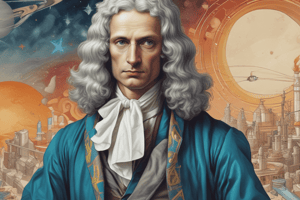Podcast
Questions and Answers
What is one of the most well-known stories about Sir Isaac Newton?
What is one of the most well-known stories about Sir Isaac Newton?
The story of Sir Isaac Newton 'discovering gravity' as a result of an apple falling from a tree over his head.
When was Sir Isaac Newton born?
When was Sir Isaac Newton born?
January 4, 1643.
What was the Scientific Revolution?
What was the Scientific Revolution?
The Scientific Revolution was a movement that took place across Europe throughout the 16th-17th centuries, encouraging individual discovery and critical thinking.
What is the Scientific Revolution and when did it begin?
What is the Scientific Revolution and when did it begin?
What were Isaac Newton's major contributions to the Scientific Revolution?
What were Isaac Newton's major contributions to the Scientific Revolution?
What is Newton's Law of Universal Gravitation and how is it expressed mathematically?
What is Newton's Law of Universal Gravitation and how is it expressed mathematically?
What are Newton's Three Laws of Motion?
What are Newton's Three Laws of Motion?
How did Newton contribute to the understanding of planetary motion?
How did Newton contribute to the understanding of planetary motion?
What did Newton prove about the heliocentric model?
What did Newton prove about the heliocentric model?
What were the limitations of the refracting telescope and how did Newton improve upon it?
What were the limitations of the refracting telescope and how did Newton improve upon it?
Flashcards are hidden until you start studying




